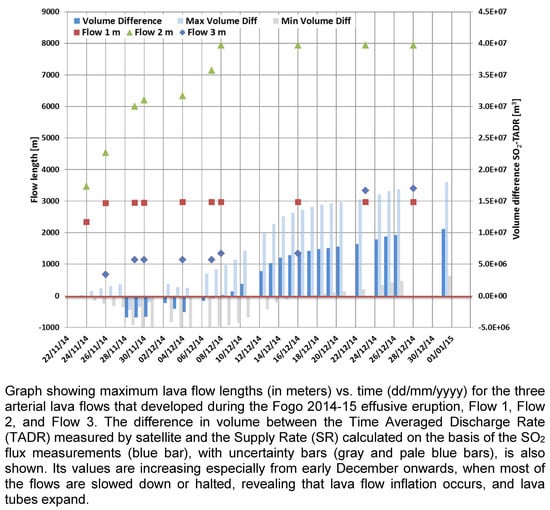Satellite and Ground Remote Sensing Techniques to Trace the Hidden Growth of a Lava Flow Field: The 2014–2015 Effusive Eruption at Fogo Volcano (Cape Verde)
Abstract
:1. Introduction
2. Geologic Background
3. Methods
3.1. Magma Supply Rate
3.2. TADR Estimation
4. Results
4.1. Chronology of the Eruption
4.2. Field Surveys and Observations of Lava Tubes
4.3. Lava Flow Field Morphology
4.4. Pyroclastic Cone
4.5. Lava Flow Field Growth
4.6. Lava Flow Field Volume
5. Discussion
6. Conclusive Remarks
Supplementary Materials
Author Contributions
Funding
Acknowledgments
Conflicts of Interest
References
- Walker, G.P.L. Lengths of lava flows. Philos. Trans. R. Soc. Lond. 1973, 274, 107–118. [Google Scholar] [CrossRef]
- Kilburn, C.R.J.; Lopes, R.M.C. The growth of aa lava flow fields on Mount Etna, Sicily. J. Geophys. Res. Solid Earth 1988, 93, 14759–14772. [Google Scholar] [CrossRef]
- Calvari, S.; Pinkerton, H. Formation of lava tubes and extensive flow field during the 1991–1993 eruption of Mount Etna. J. Geophys. Res. Solid Earth 1998, 103, 27291–27302. [Google Scholar] [CrossRef]
- Bonaccorso, A.; Calvari, S.; Boschi, E. Hazard mitigation and crisis management during major flank eruptions at Etna volcano: Reporting on real experience. In Detecting, Modelling and Responding to Effusive Eruptions; Harris, A.J.L., De Groeve, T., Garel, F., Carn, S.A., Eds.; Geological Society: London, UK, 2015; Volume 426, pp. 447–461. ISBN 978-1-86239-736-1. [Google Scholar] [CrossRef]
- Kauahikaua, J.; Cashman, K.V.; Mattox, T.N.; Heliker, C.C.; Hon, K.A.; Mangan, M.T.; Thornber, C.R. Observations on basaltic lava streams in tubes from Kilauea Volcano, island of Hawaii. J. Geophys. Res. Solid Earth 1998, 103, 27303–27323. [Google Scholar] [CrossRef]
- Calvari, S.; Coltelli, M.; Neri, M.; Pompilio, M.; Scribano, V. The 1991–1993 Etna eruption: Chronology and lava flow field evolution. Acta Vulcanol. 1994, 4, 1–14. [Google Scholar]
- Harris, A.J.L. Thermal Remote Sensing of Active Volcanoes; Cambridge University Press: Cambridge, UK, 2013; p. 728. ISBN 978-0-521-85945-5. [Google Scholar]
- Solana, M.C.; Calvari, S.; Kilburn, C.R.J.; Gutierrez, H.; Chester, D.; Duncan, A. Supporting the Development of Procedures for Communications During Volcanic Emergencies: Lessons Learnt from the Canary Islands (Spain) and Etna and Stromboli (Italy). Adv. Volcanol. 2017. [Google Scholar] [CrossRef]
- Guest, J.E.; Kilburn, C.R.J.; Pinkerton, H.; Duncan, A.M. The evolution of lava flow fields: Observations of the 1981 and 1983 eruptions of Mount Etna, Sicily. Bull. Volcanol. 1987, 49, 527–540. [Google Scholar] [CrossRef]
- Kilburn, C.R.J.; Lopes, R.M.C. General Patterns of Flow Field Growth: Aa and Blocky Lavas. J. Geophys. Res. Solid Earth 1991, 96, 19721–19732. [Google Scholar] [CrossRef]
- Guest, J.E.; Underwood, J.R.; Greeley, R. Role of lava tubes in flows from the Observatory Vent, 1971 eruption on Mount Etna. Geol. Mag. 1980, 117, 601–606. [Google Scholar] [CrossRef]
- Mattox, T.N.; Heliker, C.; Kauahikaua, J.; Hon, K. Development of the 1990 Kalapana Flow Field, Kilauea Volcano, Hawaii. Bull. Volcanol. 1993, 55, 407–413. [Google Scholar] [CrossRef]
- Calvari, S.; Pinkerton, H. Lava tube morphology on Etna and evidence for lava flow emplacement mechanisms. J. Volcanol. Geotherm. Res. 1999, 90, 263–280. [Google Scholar] [CrossRef]
- Walker, G.P.L. Structure, and origin by injection under surface crust, of tumuli, “lava rises”, “lava-rise pits”, and “lava inflation clefts” in Hawaii. Bull. Volcanol. 1991, 53, 546–558. [Google Scholar] [CrossRef]
- Hon, K.; Kauahikaua, J.; Denlinger, R.; Mackay, K. Emplacement and inflation of pahoehoe sheet flows: Observations and measurements of active lava flows on Kilauea Volcano, Hawaii. Geol. Soc. Am. Bull. 1994, 106, 351–370. [Google Scholar] [CrossRef]
- Rossi, M.J.; Gudmundsson, A. The morphology and formation of flow-lobe tumuli on Icelandic shield volcanoes. J. Volcanol. Geotherm. Res. 1996, 72, 291–308. [Google Scholar] [CrossRef]
- Cashman, K.V.; Kauahikaua, J.P. Reevaluation of vesicle distributions in basaltic lava flows. Geology 1997, 25, 419–422. [Google Scholar] [CrossRef]
- Keszthelyi, L.; Self, S. Some physical requirements for the emplacement of long basaltic lava flows. J. Geophys. Res. Solid Earth 1998, 103, 27447–27464. [Google Scholar] [CrossRef] [Green Version]
- Self, S.; Keszthelyi, L.; Thordarson, T. The importance of pahoehoe. Annu. Rev. Earth Planet. Sci. 1998, 26, 81–110. [Google Scholar] [CrossRef]
- Self, S.; Thordarson, T.; Keszthelyi, L.; Walker, G.P.L.; Hon, K.; Murphy, M.T. A new model for the emplacement of Columbia River basalts as large, inflated pahoehoe lava flow fields. Geophys. Res. Lett. 1996, 23, 2689–2692. [Google Scholar] [CrossRef]
- Thordarson, T.; Self, S. The Roza Member, Columbia River Basalt Group: A gigantic pahoehoe lava flow field formed by endogenous processes? J. Geophys. Res. Solid Earth 1998, 103, 27411–27445. [Google Scholar] [CrossRef] [Green Version]
- Applegarth, L.J.; Pinkerton, H.; James, M.R.; Calvari, S. Lava flow superposition: The reactivation of flow units in compound flow fields. J. Volcanol. Geotherm. Res. 2010, 194, 100–106. [Google Scholar] [CrossRef]
- Favalli, M.; Harris, A.J.L.; Fornaciai, A.; Pareschi, M.T.; Mazzarini, F. The distal segment of Etna’s 2001 basaltic lava flow. Bull. Volcanol. 2010, 72, 119–127. [Google Scholar] [CrossRef]
- Favalli, M.; Fornaciai, A.; Mazzarini, F.; Harris, A.J.L.; Neri, M.; Behncke, B.; Pareschi, M.T.; Tarquini, S.; Boschi, E. Evolution of an active lava flow field using a multitemporal LIDAR acquisition. J. Geophys. Res. Solid Earth 2010, 115. [Google Scholar] [CrossRef] [Green Version]
- Umino, S.; Nonaka, M.; Kauahikaua, J. Emplacement of subaerial pahoehoe lava sheet flows into water: 1990 Kaimū flow of Kilauea volcano at Kaimu Bay, Hawaii. Bull. Volcanol. 2006, 69, 125–139. [Google Scholar] [CrossRef]
- James, M.R.; Applegarth, L.J.; Pinkerton, H. Lava channel roofing, overflows, breaches and switching: Insights from the 2008–2009 eruption of Mt. Etna. Bull. Volcanol. 2012, 74, 107–117. [Google Scholar] [CrossRef]
- Hamilton, C.W.; Glaze, L.S.; James, M.R.; Baloga, S.M. Topographic and stochastic influences on pahoehoe lava lobe emplacement. Bull. Volcanol. 2013, 75, 756. [Google Scholar] [CrossRef]
- Slatcher, N.; James, M.R.; Calvari, S.; Ganci, G.; Browning, J. Quantifying effusion rates at active volcanoes through integrated time-lapse laser scanning and photography. Remote Sens. 2015, 7, 14967–14987. [Google Scholar] [CrossRef] [Green Version]
- Koeppen, W.C.; Patrick, M.; Orr, T.; Sutton, A.J.; Dow, D.; Wright, R. Constraints on the partitioning of Kīlauea’s lavas between surface and tube flows, estimated from infrared satellite data, sulfur dioxide emission rates, and field observations. Bull. Volcanol. 2013, 75, 716. [Google Scholar] [CrossRef]
- Cappello, A.; Ganci, G.; Calvari, S.; Perez, N.M.; Hernandez, P.A.; Silva, S.V.; Cabral, J.; Del Negro, C. Lava Flow Hazard Modeling during the 2014–2015 Fogo eruption, Cape Verde. J. Geophys. Res. Solid Earth 2016, 121, 2290–2303. [Google Scholar] [CrossRef]
- Sutton, A.J.; Elias, T.; Kauahikaua, J. Lava-Effusion Rates for the Puu Oo-Kupaianaha Eruption derived from SO2 Emissions and Very Low Frequency (VLF) Measurements. USGS Prof. Pap. 2003, 1676, 137–148. [Google Scholar]
- Allard, P. Endogenous magma degassing and storage at Mount Etna. Geophys. Res. Lett. 1997, 24, 2219–2222. [Google Scholar] [CrossRef] [Green Version]
- Courtney, R.C.; White, R.S. Anomalous heat flow and geoid across the Cape Verde Rise: Evidence for dynamic support from a thermal plume in the mantle. Geophys. J. R. Astr. Soc. 1986, 87, 815–867. [Google Scholar] [CrossRef]
- Amelung, F.; Day, S. InSAR observations of the 1995 Fogo, Cape Verde, eruption: Implications for the effects of collapse events upon island volcanoes. Geophys. Res. Lett. 2002, 29, 47-1–47-4. [Google Scholar] [CrossRef] [Green Version]
- Day, S.J.; Heleno da Silva, S.I.N.; Fonseca, J.F.B.D. A past giant lateral collapse and present-day flank instability of Fogo, Cape Verde Islands. J. Volcanol. Geotherm. Res. 1999, 94, 191–218. [Google Scholar] [CrossRef]
- Ramalho, R.S.; Winckler, G.; Madeira, J.; Helffrich, G.R.; Hipolito, A.; Quartau, R.; Adena, K.; Schaefer, J.M. Hazard potential of volcanic flank collapses raised by new megatsunami evidence. Sci. Adv. 2015, 1, e1500456. [Google Scholar] [CrossRef] [PubMed] [Green Version]
- Hildner, E.; Klügel, A.; Hauff, F. Magma storage and ascent during the 1995 eruption of Fogo, Cape Verde Archipelago. Contrib. Mineral. Petrol. 2011, 162, 751–772. [Google Scholar] [CrossRef]
- Escrig, S.; Doucelance, R.; Moreira, M.; Allègre, C.J. Os isotope systematics in Fogo Island: Evidence for lower continental crust fragments under the Cape Verde Southern Islands. Chem. Geol. 2005, 219, 93–113. [Google Scholar] [CrossRef]
- Texier-Teixeira, P.; Chouraqui, F.; Perrillat-Collomb, A.; Lavigne, F.; Cadag, J.R.; Grancher, D. Reducing volcanic risk on Fogo Volcano, Cape Verde, through a participatory approach: Which outcome? Nat. Hazards Earth Syst. Sci. 2014, 14, 2347–2358. [Google Scholar] [CrossRef]
- Dionis, S.M.; Melian, G.; Rodriguez, F.; Hernandez, P.A.; Padron, E.; Perez, N.M.; Barrancos, J.; Padilla, G.; Sumino, H.; Fernandes, P.; et al. Diffuse volcanic gas emission and thermal energy release from the summit crater of Pico do Fogo, Cape Verde. Bull. Volcanol. 2015, 77, 10. [Google Scholar] [CrossRef]
- Dionis, S.M.; Perez, N.M.; Hernandez, P.A.; Melian, G.; Rodriguez, F.; Padron, E.; Sumino, H.; Barrancos, J.; Padilla, G.; Fernandes, P.; et al. Diffuse CO2 degassing and volcanic activity at Cape Verde islands, West Africa. Earth Plan. Space 2015, 67, 48. [Google Scholar] [CrossRef]
- Pérez, N.M.; Dionis, S.; Fernandes, P.; Barrancos, J.; Rodríguez, F.; Bandomo, Z.; Hernández, P.A.; Melián, G.V.; Silva, S.; Padilla, G.; et al. Precursory signals of the 2014–15 Fogo eruption (Cape Verde) detected by surface CO2 emission and heat flow observations. In Proceedings of the EGU General Assembly 2015, Vienna, Austria, 12–17 April 2015. [Google Scholar]
- Barrancos, J.; Dionis, S.; Quevedo, R.; Fernandes, P.; Rodríguez, F.; Pérez, N.M.; Silva, S.; Cardoso, N.; Hernández, P.A.; Melián, G.V.; et al. Sulphur dioxide (SO2) emissions during the 2014–15 Fogo eruption, Cape Verde. In Proceedings of the EGU General Assembly 2015, Vienna, Austria, 12–17 April 2015. [Google Scholar]
- Galle, B.; Oppenheimer, C.; Geyer, A.; McGonigle, A.; Edmonds, M.; Horrocks, L.A. A miniaturized ultraviolet spectrometer for remote sensing of SO2 fluxes: A new tool for volcano surveillance. J. Volcanol. Geotherm. Res. 2002, 119, 241–254. [Google Scholar] [CrossRef]
- Barrancos, J.; Roselló, J.I.; Calvo, D.; Padrón, E.; Melián, G.; Hernández, P.A.; Pérez, N.M.; Millán, M.M.; Galle, B. SO2 emission from active volcanoes measured simultaneously by COSPEC and mini-DOAS. Pure Appl. Geophys. 2008, 165, 115–133. [Google Scholar] [CrossRef]
- Mata, J.; Martins, N.; Mattielli, N.; Madeira, J.; Faria, B.; Ramalho, R.S.; Silva, P.; Moreira, M.; Caldeira, R.; Rodrigues, J.; et al. The 2014–15 eruption and the short-term geochemical evolution of the Fogo volcano (Cape Verde): Evidence for small-scale mantle heterogeneity. Lithos 2017, 288–289, 91–107. [Google Scholar] [CrossRef]
- Spilliaert, N.; Allard, P.; Metrich, N.; Sobolev, A.V. Melt inclusion record of the conditions of ascent, degassing, and extrusion of volatile-rich alkali basalt during the powerful 2002 flank eruption of Mount Etna (Italy). J. Geophys. Res. Solid Earth 2006, 111. [Google Scholar] [CrossRef] [Green Version]
- Steffke, A.M.; Harris, A.J.L.; Burton, M.; Caltabiano, T.; Salerno, G.G. Coupled use of COSPEC and satellite measurements to define the volumetric balance during effusive eruptions at Mt. Etna, Italy. J. Volcanol. Geotherm. Res. 2010, 205, 47–53. [Google Scholar] [CrossRef]
- Caltabiano, T.; Burton, M.; Giammanco, S.; Allard, P.; Bruno, N.; Muré, F.; Romano, R. Volcanic gas emissions from the summit craters and flanks of Mt. Etna, 1987–2000. In Mt. Etna: Volcano Laboratory; Bonaccorso, A., Calvari, S., Coltelli, M., Del Negro, C., Falsaperla, S., Eds.; American Geophysical Union: Washington, DC, USA, 2004; Volume 143, pp. 111–128. ISBN 0-87590-408-4. [Google Scholar] [CrossRef]
- Ganci, G.; Bilotta, G.; Cappello, A.; Hérault, A.; Del Negro, C. HOTSAT: A multiplatform system for the satellite thermal monitoring of volcanic activity. In Detecting, Modelling and Responding to Effusive Eruptions; Harris, A.J.L., De Groeve, T., Garel, F., Carn, S.A., Eds.; Geological Society: London, UK, 2015; Volume 426, pp. 207–222. ISBN 978-1-86239-736-1. [Google Scholar]
- Harris, A.J.L.; Dehn, J.; Calvari, S. Lava effusion rate definition and measurement: A review. Bull. Volcanol. 2007, 70, 1. [Google Scholar] [CrossRef]
- Ganci, G.; Vicari, A.; Bonfiglio, S.; Gallo, G.; Del Negro, C. A texton-based cloud detection algorithm for MSG-SEVIRI multispectral images. Geomat. Nat. Hazards Risk 2011, 2, 279–290. [Google Scholar] [CrossRef] [Green Version]
- Ganci, G.; Vicari, A.; Fortuna, L.; Del Negro, C. The HOTSAT volcano monitoring system based on combined use of SEVIRI and MODIS multispectral data. Ann. Geophys. 2011, 54, 544–550. [Google Scholar] [CrossRef]
- Wooster, M.; Zhukov, B.; Oertel, D. Fire radiative energy release for quantitative study of biomass burning: Derivation from the BIRD experimental satellite and comparison to MODIS fire products. Remote Sens. Environ. 2003, 86, 83–107. [Google Scholar] [CrossRef]
- Ganci, G.; James, M.R.; Calvari, S.; Del Negro, C. Separating the thermal fingerprints of lava flows and simultaneous lava fountaining using ground-based thermal camera and SEVIRI measurements. Geophys. Res. Lett. 2013, 40, 5058–5063. [Google Scholar] [CrossRef] [Green Version]
- Spampinato, L.; Ganci, G.; Hernández, P.A.; Calvo, D.; Tedesco, D.; Pérez, N.M.; Calvari, S.; Del Negro, C.; Yalire, M.M. Thermal insights into the dynamics of Nyiragongo lava lake from ground and satellite measurements. J. Geophys. Res. Solid Earth 2013, 118, 5771–5784. [Google Scholar] [CrossRef] [Green Version]
- Harris, A.; Blake, S.; Rothery, D.; Stevens, N. A chronology of the 1991 to 1993 Mount Etna eruption using advanced very high resolution radiometer data: Implications for real-time thermal volcano monitoring. J. Geophys. Res. Solid Earth 1997, 102, 7985–8003. [Google Scholar] [CrossRef] [Green Version]
- Patrick, M.R.; Harris, A.J.L.; Ripepe, M.; Dehn, J.; Rothery, D.A.; Calvari, S. Strombolian explosive styles and source conditions: Insights from thermal (FLIR) video. Bull. Volcanol. 2007, 69, 769–784. [Google Scholar] [CrossRef]
- Richter, N.; Favalli, M.; Zeeuw-van Dalfsen, E.; Fornaciai, A.; da Silva Fernandes, R.M.; Perez Rodriguez, N.; Levy, J.; Silva, S.V.; Walter, T.R. Lava flow hazard at Fogo Volcano, Cape Verde, before and after the 2014–2015 eruption. Nat. Hazards Earth Syst. Sci. Discuss. 2016, 16, 1925–1951. [Google Scholar] [CrossRef]
- Oze, C.; Winter, J.D. The occurrence, vesiculation, and solidification of dense blue glassy pahoehoe. J. Volcanol. Geotherm. Res. 2005, 142, 285–301. [Google Scholar] [CrossRef]
- Gonzales, A.R.; Pérez Torrado, F.J.; Carracedo Gómez, J.C.; Medina, C.J.M.; Garcia, A.B.; de la Torre, E.G.; Cigala, A.N.; Paris, R.; Rodrigues, A.N.; Dinis, H.A.; et al. Carta Geológica Ilha do Fogo, Cabo Verde; D.L.: GC 372-2015; Mercurio Editorial: Madrid, Spain, 2015; ISBN 978-84-943863-8-1. [Google Scholar]
- Houghton, B.F.; Schmincke, H.-U. Rothenberg scoria cone, East Eifel: A complex Strombolian and phreatomagmatic volcano. Bull. Volcanol. 1989, 52, 28–48. [Google Scholar] [CrossRef]
- Calvari, S.; Pinkerton, H. Birth, growth and morphologic evolution of the “Laghetto” cinder cone during the 2001 Etna eruption. J. Volcanol. Geotherm. Res. 2004, 132, 225–239. [Google Scholar] [CrossRef]
- Behncke, B.; Branca, S.; Corsaro, R.A.; De Beni, E.; Miraglia, L.; Proietti, C. The 2011–2012 summit activity of Mount Etna: Birth, growth and products of the new SE crater. J. Volcanol. Geotherm. Res. 2014, 270, 10–21. [Google Scholar] [CrossRef]
- Bonaccorso, A.; Calvari, S.; Linde, A.; Sacks, S. Eruptive processes leading to the most explosive lava fountain at Etna volcano: The 23 November 2013 episode. Geophys. Res. Lett. 2014, 41, 4912–4919. [Google Scholar] [CrossRef] [Green Version]
- Bagnardi, M.; Gonzales, P.J.; Hooper, A. High-resolution digital elevation model from tri-stereo Pleiades-1 satellite imagery for lava flow volume estimates at Fogo Volcano. Geophys. Res. Lett. 2016, 43, 6267–6275. [Google Scholar] [CrossRef] [Green Version]
- Stevens, N.F.; Wadge, G.; Williams, C.A.; Morley, J.G.; Muller, J.-P.; Murray, J.B.; Upton, M. Surface movements of emplaced lava flows measured by synthetic aperture radar interferometry. J. Geophys. Res. Solid Earth 2001, 106, 11293–11313. [Google Scholar] [CrossRef] [Green Version]
- Del Negro, C.; Fortuna, L.; Herault, A.; Vicari, A. Simulations of the 2004 lava flow at Etna volcano using the magflow cellular automata model. Bull. Volcanol. 2008, 70, 805–812. [Google Scholar] [CrossRef] [Green Version]
- Herault, A.; Vicari, A.; Ciraudo, A.; Del Negro, C. Forecasting lava flow hazards during the 2006 Etna eruption: Using the MAGFLOW cellular automata model. Comput. Geosci. 2009, 35, 1050–1060. [Google Scholar] [CrossRef]
- Favalli, M.; Chirico, G.D.; Papale, P.; Pareschi, M.T.; Boschi, E. Lava flow hazard at Nyiragongo volcano, DRC. Bull. Volcanol. 2009, 71, 363–374. [Google Scholar] [CrossRef]
- Favalli, M.; Chirico, G.D.; Papale, P.; Pareschi, M.T.; Coltelli, M.; Lucaya, N.; Boschi, E. Computer simulations of lava flow paths in the town of Goma, Nyiragongo volcano, Democratic Republic of Congo. J. Geophys. Res. 2006, 111. [Google Scholar] [CrossRef] [Green Version]
- Farquharson, J.I.; James, M.R.; Tuffen, H. Examining rhyolite lava flow dynamics through photo-based 3D reconstructions of the 2011–2012 lava flow field at Cordón-Caulle, Chile. J. Volcanol. Geotherm. Res. 2015, 304, 336–348. [Google Scholar] [CrossRef]
- Magnall, N.; James, M.R.; Tuffen, H.; Vye-Brown, C. Emplacing a cooling-limited rhyolite lava flow: Similarities with basaltic lava flows. Front. Earth Sci. 2017, 5, 44. [Google Scholar] [CrossRef]
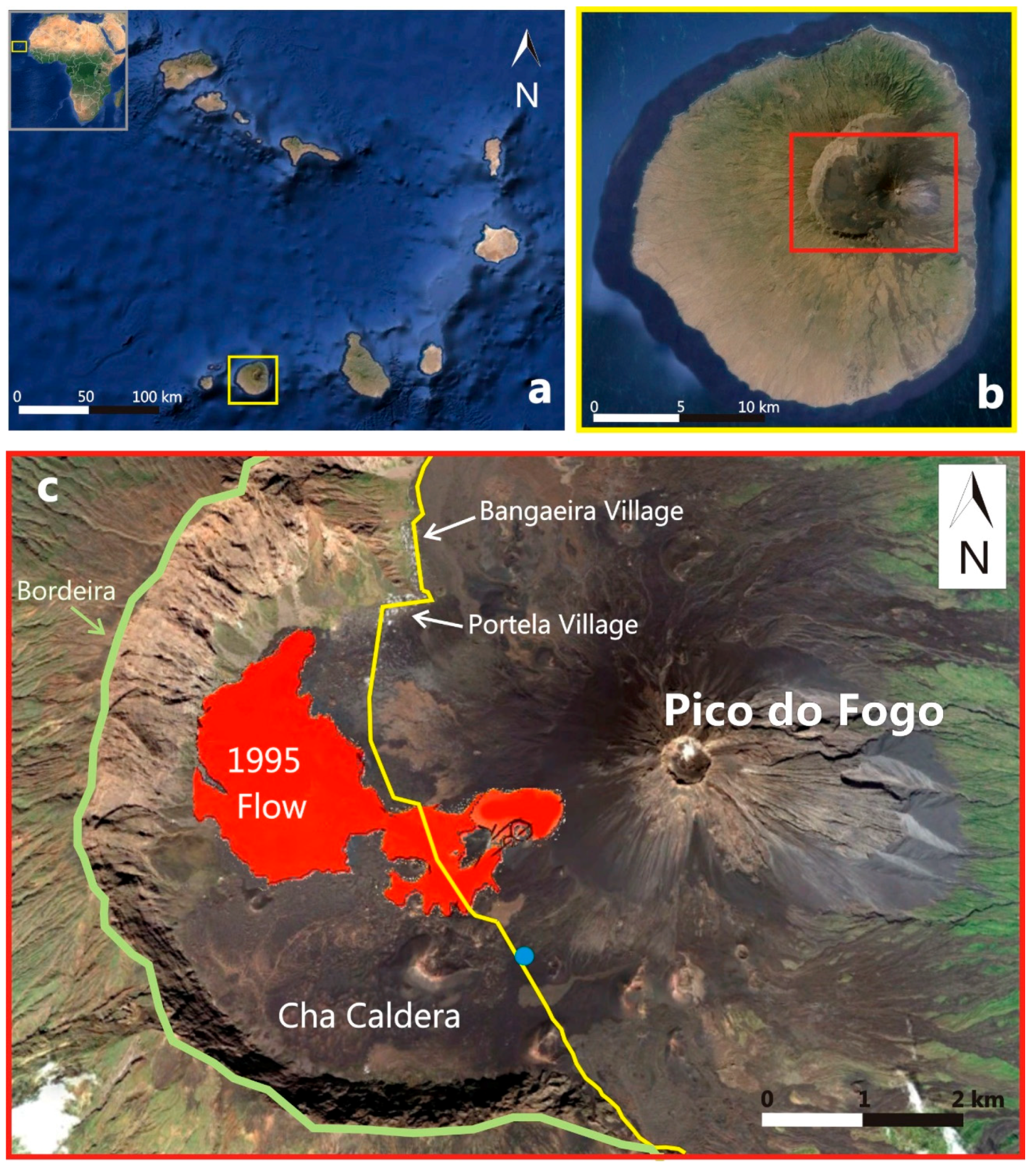
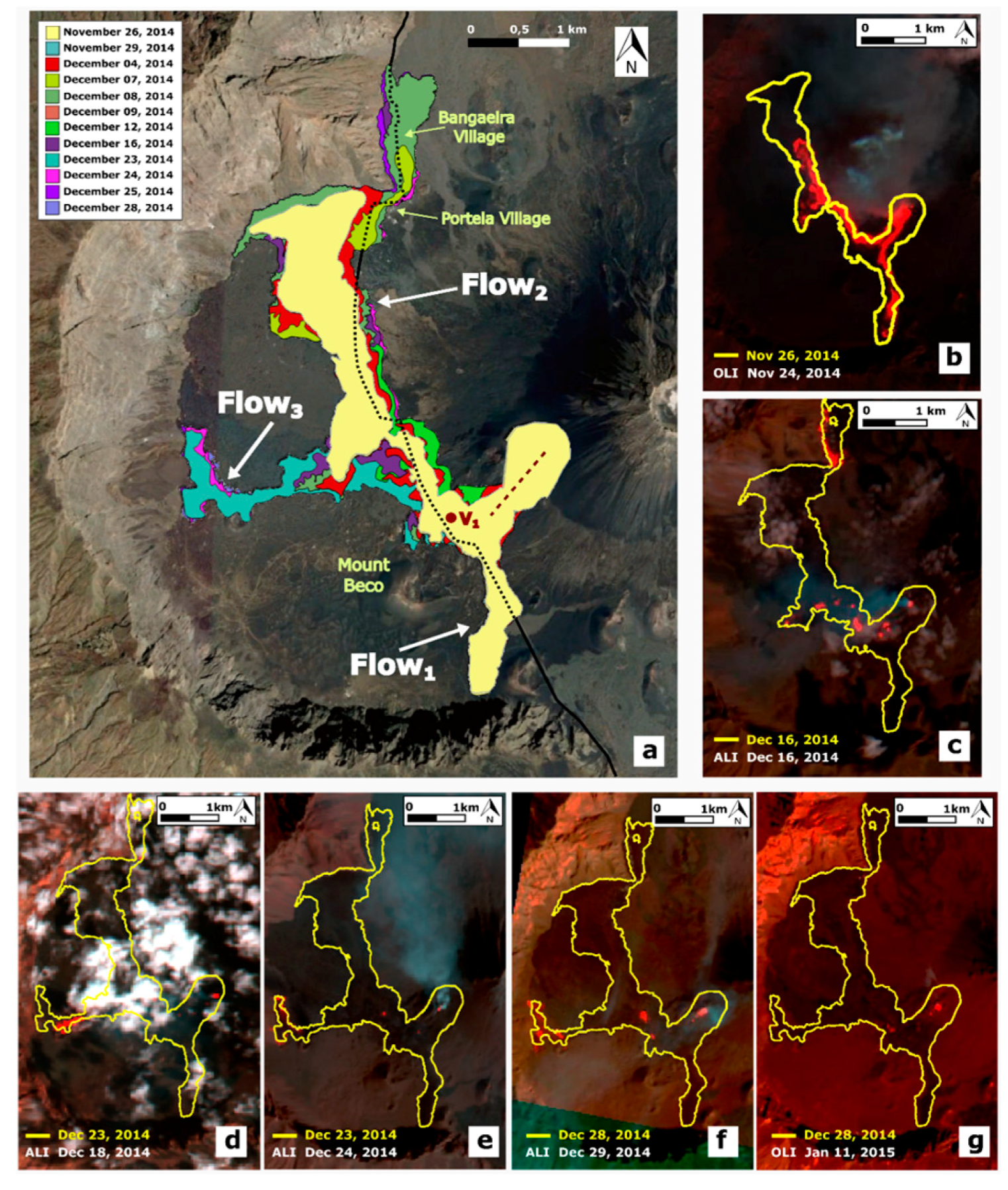


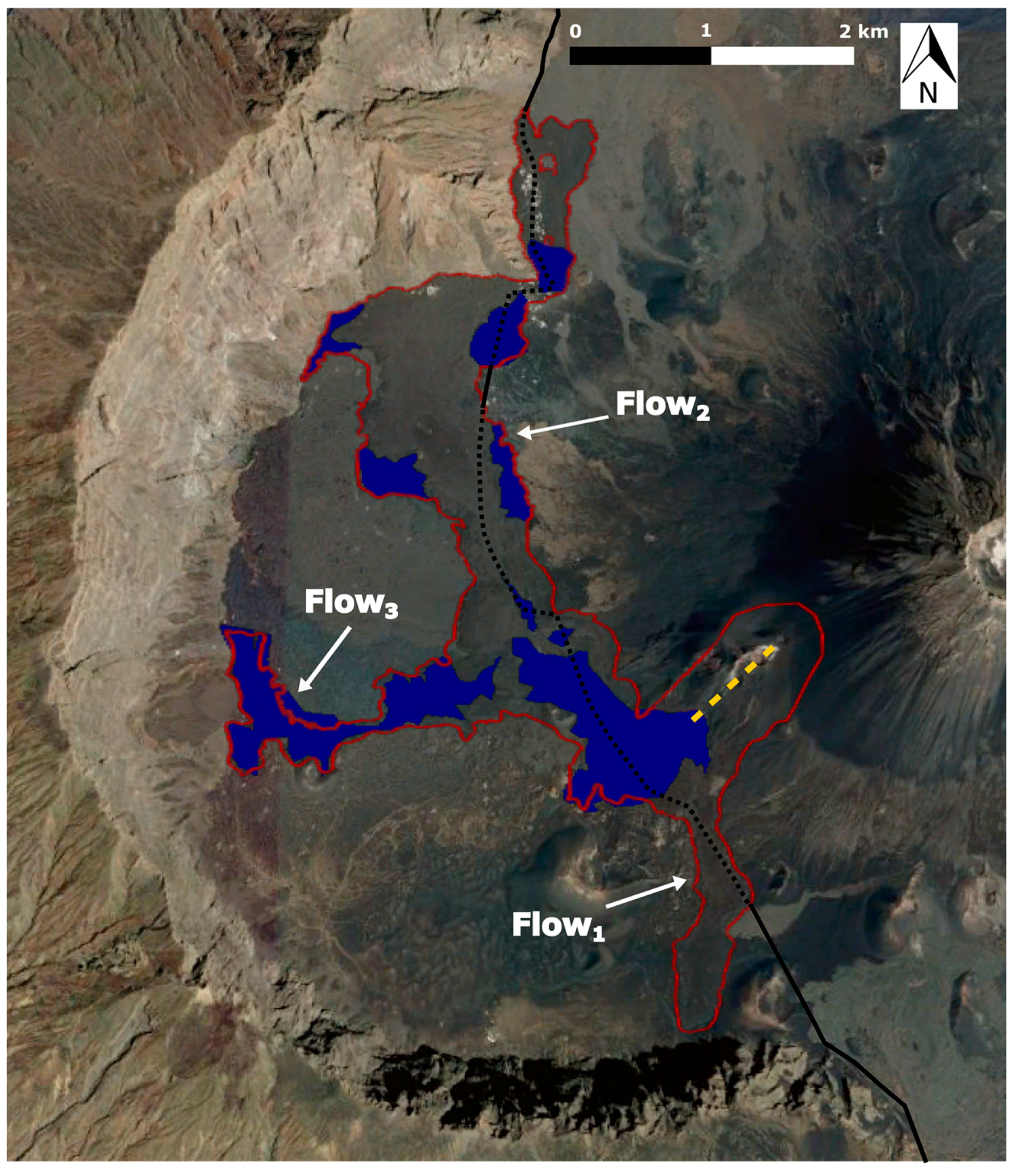

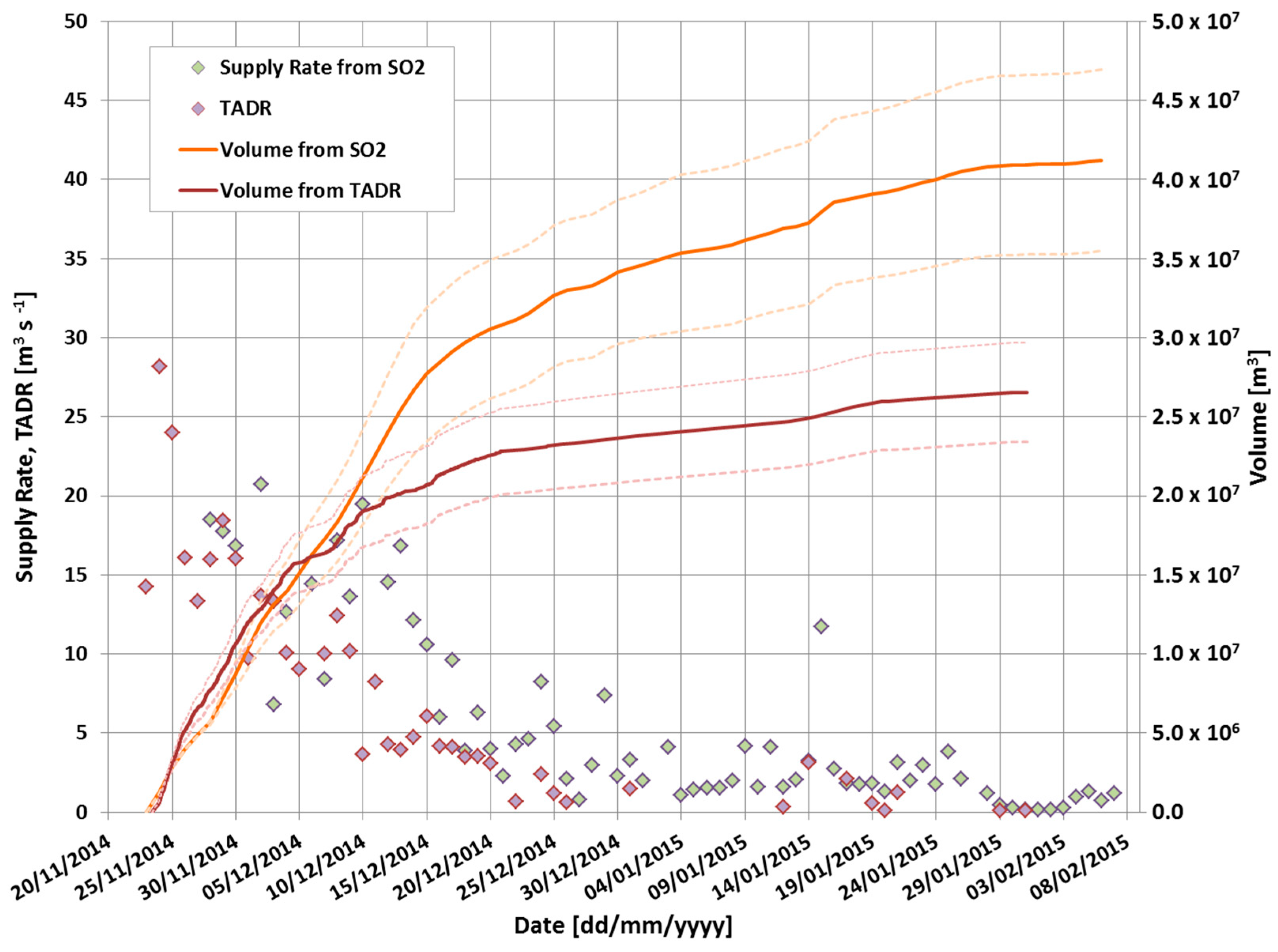
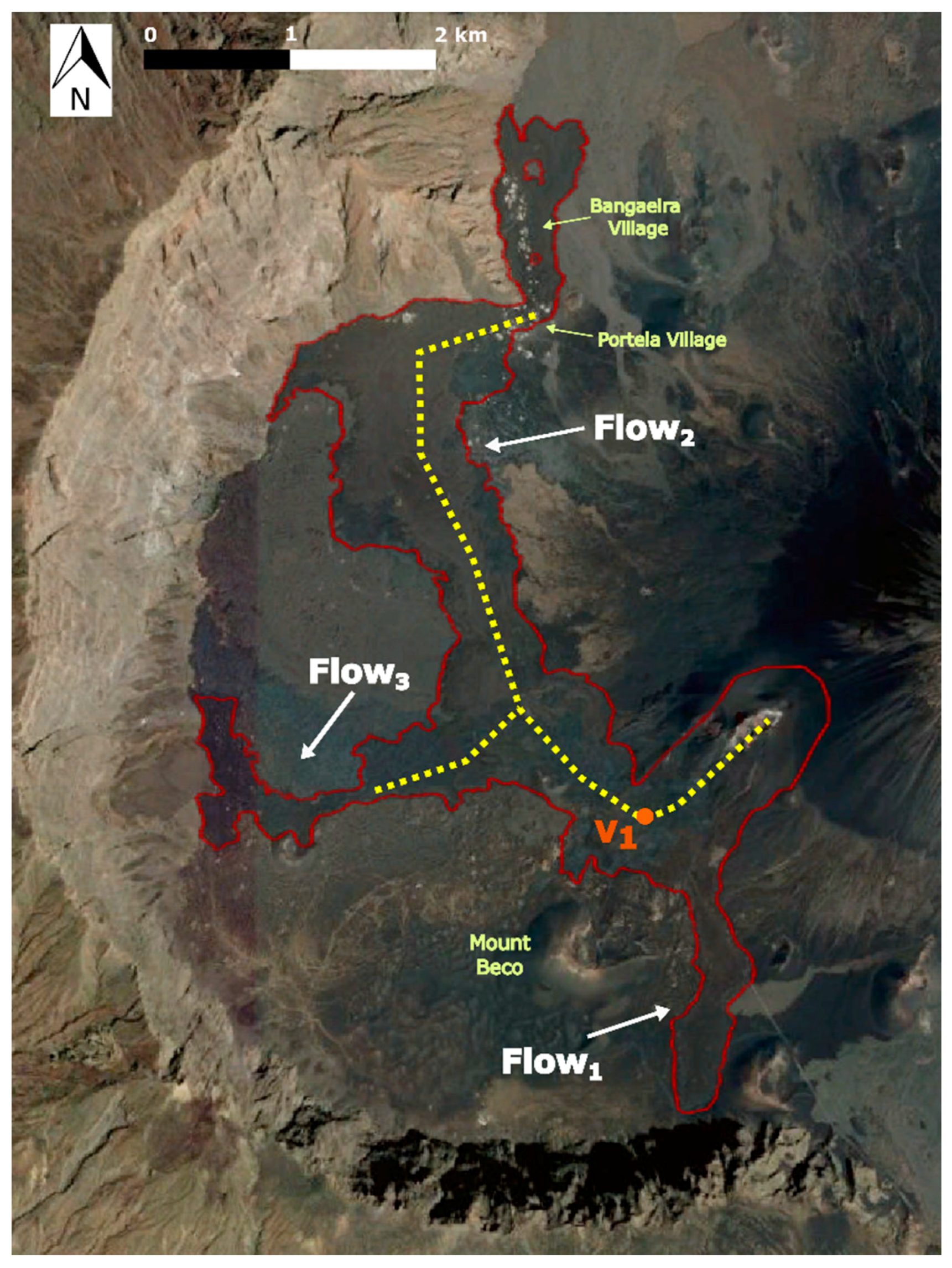
© 2018 by the authors. Licensee MDPI, Basel, Switzerland. This article is an open access article distributed under the terms and conditions of the Creative Commons Attribution (CC BY) license (http://creativecommons.org/licenses/by/4.0/).
Share and Cite
Calvari, S.; Ganci, G.; Victória, S.S.; Hernandez, P.A.; Perez, N.M.; Barrancos, J.; Alfama, V.; Dionis, S.; Cabral, J.; Cardoso, N.; et al. Satellite and Ground Remote Sensing Techniques to Trace the Hidden Growth of a Lava Flow Field: The 2014–2015 Effusive Eruption at Fogo Volcano (Cape Verde). Remote Sens. 2018, 10, 1115. https://doi.org/10.3390/rs10071115
Calvari S, Ganci G, Victória SS, Hernandez PA, Perez NM, Barrancos J, Alfama V, Dionis S, Cabral J, Cardoso N, et al. Satellite and Ground Remote Sensing Techniques to Trace the Hidden Growth of a Lava Flow Field: The 2014–2015 Effusive Eruption at Fogo Volcano (Cape Verde). Remote Sensing. 2018; 10(7):1115. https://doi.org/10.3390/rs10071115
Chicago/Turabian StyleCalvari, Sonia, Gaetana Ganci, Sónia Silva Victória, Pedro A. Hernandez, Nemesio M. Perez, José Barrancos, Vera Alfama, Samara Dionis, Jeremias Cabral, Nadir Cardoso, and et al. 2018. "Satellite and Ground Remote Sensing Techniques to Trace the Hidden Growth of a Lava Flow Field: The 2014–2015 Effusive Eruption at Fogo Volcano (Cape Verde)" Remote Sensing 10, no. 7: 1115. https://doi.org/10.3390/rs10071115





